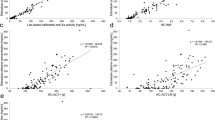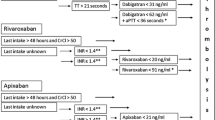Abstract
Plasma levels of Rivaroxaban (RivLev) might be useful to guide therapeutic decisions in patients with acute stroke under Rivaroxaban. A prerequisite for the potential clinical usefulness is their rapid availability in emergency situations. Single-center explorative analysis from the Novel-Oral-Anticoagulants-in-Stroke-Patients-registry (NOACISP, cinicaltrials.gov:NCT02353585). We included consecutive patients with acute ischemic or hemorrhagic stroke under Rivaroxaban (last intake <48 h) in which RivLev determined by an automated anti-factor Xa-based chromogenic assay (Hyphen-Biomed, France) are available. Primary endpoint was the turnaround time (TAT), defined as time from registration of the blood sample in the lab to first result published. Furthermore, we studied, whether TAT is influenced by (1) on- and off-hour-measurements and (2) early versus later patient arrival (cut-off: 270 min after symptom onset). Thirty-eight patients met the eligibility criteria (mean age 77 years, 44 % female). TAT was 34 min (IQR 29–65 min). TATs were similar for on- (n = 14; median 34 min; IQR 30–56 min) and off-hours-TATs (n = 24; median 35 min; IQR 29–75 min) as well as for early (n = 16; median 33 min; IQR 30–40 min) and late patient arrival (n = 22, median 34 min, IQR 28–58 min; all nonsignificant.). Taking into account RivLev in the decision process about the use of intravenous thrombolysis, three patients received intravenous thrombolysis on an individualized basis, none of them with bleeding complications. Emergency measurement of RivLev among patients with acute stroke is available within a median of 34 min and therefore feasible for ED use. Due to the rapid availability, further research to evaluate the role of RivLev in order to guide acute treatment decisions is warranted.

Similar content being viewed by others
References
Ruff CT, Giugliano RP, Braunwald E et al (2014) Comparison of the efficacy and safety of new oral anticoagulants with warfarin in patients with atrial fibrillation: a meta-analysis of randomised trials. The Lancet 383:955–962
Cuker A, Husseinzadeh H (2015) Laboratory measurement of the anticoagulant activity of edoxaban: a systematic review. J Thromb Thrombolysis 39:288–294
Steiner T, Bohm M, Dichgans M et al (2013) Recommendations for the emergency management of complications associated with the new direct oral anticoagulants (DOACs), apixaban, dabigatran and rivaroxaban. Clin Res Cardiol 102:399–412
Rizos T, Herweh C, Jenetzky E et al (2009) Point-of-care international normalized ratio testing accelerates thrombolysis in patients with acute ischemic stroke using oral anticoagulants. Stroke 40:3547–3551
Rizos T, Jenetzky E, Herweh C et al (2010) Point-of-care reversal treatment in phenprocoumon-related intracerebral hemorrhage. Ann Neurol 67:788–793
Douxfils J, Tamigniau A, Chatelain B et al (2013) Comparison of calibrated chromogenic anti-Xa assay and PT tests with LC-MS/MS for the therapeutic monitoring of patients treated with rivaroxaban. Thromb Haemost 110:723–731
Harenberg J, Kraemer R (2012) Measurement of the new anticoagulants. Thromb Res 129(Suppl 1):S106–S113
Mueck W, Lensing AW, Agnelli G, Decousus H, Prandoni P, Misselwitz F (2011) Rivaroxaban: population pharmacokinetic analyses in patients treated for acute deep-vein thrombosis and exposure simulations in patients with atrial fibrillation treated for stroke prevention. Clin Pharmacokinet 50:675–686
Seiffge DJ, Traenka C, Gensicke H et al (2014) Intravenous thrombolysis in stroke patients receiving rivaroxaban. Eur J Neurol 21:e3–e4
Gensicke H, Strbian D, Zinkstok SM et al (2016) Intravenous thrombolysis in patients dependent on the daily help of Others before stroke. Stroke 47:450–456
Gensicke H, Zinkstok SM, Roos YB et al (2013) IV thrombolysis and renal function. Neurology 81:1780–1788
Seiffge DJ, Hooff RJ, Nolte CH et al (2015) Recanalization therapies in acute ischemic stroke patients: impact of prior treatment with novel oral anticoagulants on bleeding complications and outcome. Circulation 132:1261–1269
Ringelstein EB, Chamorro A, Kaste M et al (2013) European stroke organisation recommendations to establish a stroke unit and stroke center. Stroke 44:828–840
Cuker A, Siegal DM, Crowther MA, Garcia DA (2014) Laboratory measurement of the anticoagulant activity of the non-vitamin K oral anticoagulants. J Am Coll Cardiol 64:1128–1139
Reilly PA, Lehr T, Haertter S et al (2014) The effect of dabigatran plasma concentrations and patient characteristics on the frequency of ischemic stroke and major bleeding in atrial fibrillation patients: the RE-LY Trial (randomized evaluation of long-term anticoagulation therapy). J Am Coll Cardiol 63:321–328
Ruff CT, Giugliano RP, Braunwald E et al (2015) Association between edoxaban dose, concentration, anti-Factor Xa activity, and outcomes: an analysis of data from the randomised, double-blind ENGAGE AF-TIMI 48 trial. The Lancet 385:2288–2295
Acknowledgments
The NOACISP registry was supported by a grant from the Swiss Heart Foundation. David J. Seiffge was supported by a fellowship for excellent young researchers from the University of Basel.
Author contributions
Study concept and design: David J. Seiffge, Dimitrios Tsakiris and Stefan Engelter. Funding: David J. Seiffge and Stefan Engelter. Data acquisition: all authors. Data analysis and interpretation: David J. Seiffge, Dimitrios Tsakiris and Stefan Engelter. Drafting of the manuscript: David J. Seiffge and Stefan Engelter. Critical review of manuscript for important intellectual content: all authors. Supervision of the study/registry: Dimitrios Tsakiris and Stefan Engelter.
Author information
Authors and Affiliations
Corresponding author
Ethics declarations
Conflict of interest
Christopher Traenka, Lisa Hert, Alexandros Polymeris, Christian H. Nickel, Urs Fisch, Raphael Guzman and Dimitrios Tsakiris have no conflicts of interest.
Disclosures
David J. Seiffge has received funding from the Swiss Heart Foundation, the Science Funds of the University Hospital Basel and the University of Basel and served on a scientific advisory board for Bayer. Nils Peters has received travel honoraria from Boehringer-Ingelheim, honoraria for advisory board from Bayer, Boehringer-Ingelheim and BMS/Pfizer as well as funding from Bayer, Boehringer-Ingelheim, BMS/Pfizer, CSL Behring, Covidien and Eisai. Leo H Bonati has received funding from the Swiss National Science Foundation, the University of Basel, and the Swiss Heart Foundation, received travel honoraria from Bayer and served on scientific advisory boards for Bayer. Gian Marco De Marchis was supported by the following grants: Swiss National Science Foundation; Swisslife Jubiläumsstiftung for Medical Research; Swiss Neurological Society; Bangerter-Rhyner-Stiftung; Fondazione Dr. Ettore Balli (Switzerland); travel honoraria by Bayer; De Quervain research grant for young clinical investigators of the Clinical Trial Unit, University of Bern (Switzerland). Philipp A. Lyrer has served on scientific advisory boards for Bayer, Daiichi-Sankyo, Schering Pharma, and Boehringer Ingelheim has received funding for travel or speaker honoraria from Bayer Schering Pharma, Boehringer Ingelheim, and Shire plc; he has received research support from AstraZeneca, Boehringer Ingelheim, Sanofi-aventis, PhotoThera, the Swiss National Science Foundation, and the Swiss Heart Foundation. Stefan Engelter has received funding for travel or speaker honoraria from Bayer and Boehringer Ingelheim, he has served on scientific advisory boards for Bayer, Boehringer Ingelheim, BMS/Pfizer, and Covidien and on the editorial board of Stroke. He has received an educational grant from Pfizer and research support from the Science Funds [Wissenschaftsfonds] of the University Hospital Basel, the University Basel, the Swiss Heart Foundation, and the Swiss National Science Foundation.
Additional information
Dimitrios Tsakiris and Stefan Engelter have equally contributed to this work.
Rights and permissions
About this article
Cite this article
Seiffge, D.J., Traenka, C., Polymeris, A. et al. Feasibility of rapid measurement of Rivaroxaban plasma levels in patients with acute stroke. J Thromb Thrombolysis 43, 112–116 (2017). https://doi.org/10.1007/s11239-016-1431-7
Published:
Issue Date:
DOI: https://doi.org/10.1007/s11239-016-1431-7




